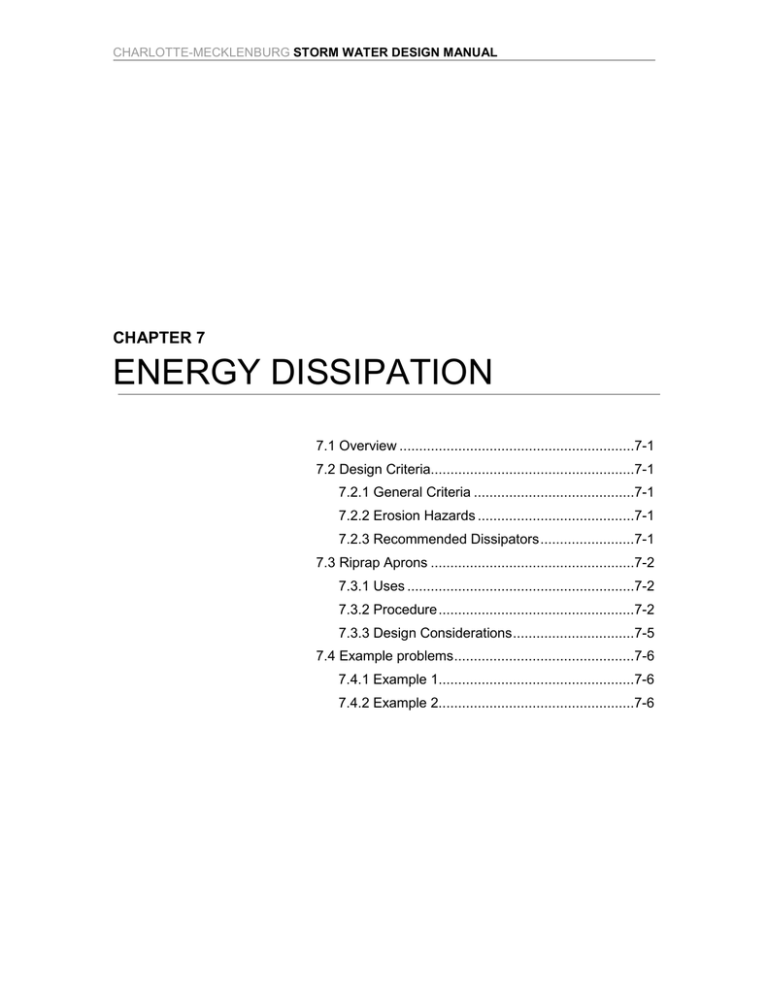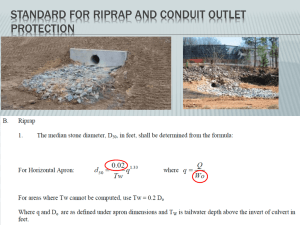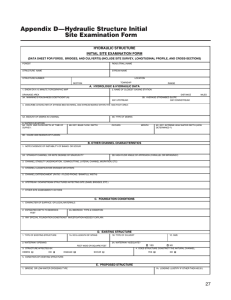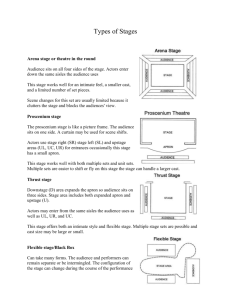ENERGY DISSIPATION CHAPTER 7
advertisement

CHARLOTTE-MECKLENBURG STORM WATER DESIGN MANUAL CHAPTER 7 ENERGY DISSIPATION 7.1 Overview ............................................................7-1 7.2 Design Criteria....................................................7-1 7.2.1 General Criteria .........................................7-1 7.2.2 Erosion Hazards ........................................7-1 7.2.3 Recommended Dissipators ........................7-1 7.3 Riprap Aprons ....................................................7-2 7.3.1 Uses ..........................................................7-2 7.3.2 Procedure ..................................................7-2 7.3.3 Design Considerations ...............................7-5 7.4 Example problems ..............................................7-6 7.4.1 Example 1..................................................7-6 7.4.2 Example 2..................................................7-6 CHAPTER 7 ENERGY DISSIPATION 7.1 OVERVIEW The purpose of this chapter is to aid in selecting and designing energy dissipators for controlling erosive velocities. Since some outlet protection is required downstream from all drainage facilities, the design of an energy dissipator becomes an integral part of the drainage facility design. 7.2 DESIGN CRITERIA 7.2.1 General Criteria Energy dissipators shall be employed whenever the velocity of flows leaving a storm water management facility exceeds the erosive velocity of the downstream channel system. Several standard energy dissipator designs have been documented by the U.S. Department of Transportation including impact basins, drop structures, stilling wells, and riprap. 7.2.2 Erosion Hazards Erosion problems at the outlets of culverts or detention basins are common. Determination of the flow conditions, scour potential, and channel erosion resistance should be standard procedure for all designs. The only safe procedure is to design on the basis that erosion at a culvert outlet and the downstream channel is to be expected. Two types of scour can occur in the vicinity of culvert and other outlets; general channel degradation and local scour. Channel degradation may proceed in a fairly uniform manner over a long length, or may be evident in one or more abrupt drops progressing upstream with every runoff event. The abrupt drops, referred to as head cutting, can be detected by location surveys or by periodic maintenance following construction. Local scour is the result of high-velocity flow at the culvert outlet, but its effect extends only a limited distance downstream. The highest outlet velocities will be produced by long, smoothbarrel culverts and channels on steep slopes. At most sites these cases will require protection of the outlet. However, protection is also often required for culverts and channels on mild slopes. For these culverts flowing full, the outlet velocity will be critical velocity with low tailwater and full barrel velocity for high tailwater. Standard practice is to use the same treatment at the culvert entrance and exit. It is important to recognize that the inlet is designed to improve culvert capacity or reduce headloss while the outlet structure should provide a smooth flow transition back to the natural channel or into an energy dissipator. Outlet structures should provide uniform redistribution or spreading of the flow without excessive separation and turbulence. 7.2.3 Recommended Dissipators For many designs, the following outlet protection and energy dissipators provide sufficient protection at a reasonable cost. Plunge pools Riprap apron Baffled outlets 7-1 CHARLOTTE-MECKLENBURG STORM WATER DESIGN MANUAL This chapter will focus on riprap aprons. The reader is referred to the North Carolina Erosion and Sediment Control Planning and Design Manual and to the Federal Highway Administration Hydraulic Engineering Circular No. 14 (HEC- 14: Hydraulic Design of Energy Dissipators For Culverts and Channels) for design procedures of other energy dissipators. 7.3 RIPRAP APRONS 7.3.1 Uses A flat riprap apron can be used to prevent erosion at the transition from a pipe or box culvert outlet to a natural channel, or onto a flat, open surface. Protection is provided primarily by having sufficient length, roughness, and flare to dissipate the energy by allowing the flow to expand and slow down. Riprap aprons shall be used when the culvert outlet velocity exceeds the erosive velocity of the receiving channel or soil. Riprap aprons are appropriate when the culvert outlet velocity is less than or equal to 10 fps for pipes ≤ 48 inches in diameter. Unincorporated Mecklenburg County and the six Towns require a velocity less than or equal to 5 fps for all pipes. Riprap aprons downstream from flared end sections must adhere to standard 20.23 of the Charlotte and Mecklenburg County Land Development Standards Manuals. 7.3.2 Procedure The procedure presented in this section is taken from USDA, SCS (1975). Two sets of curves, one for minimum and one for maximum tailwater conditions, are used to determine the apron size and the median riprap diameter, d50. If tailwater conditions are known, or if both minimum and maximum conditions may occur, the apron should be designed to meet criteria for both. Although the design curves are based on round pipes flowing full, the can be used for partially full pipes and box culverts. The design procedure consists of the following steps: 1. If possible, determine tailwater conditions for the channel. If tailwater is less than onehalf the discharge flow depth (pipe diameter if flowing full), minimum tailwater conditions exist and the curves in Figure 7-1 apply. Otherwise, maximum tailwater conditions exist and the curves in Figure 7-2 should be used. 2. Determine the correct apron length and median riprap diameter, d50, using the appropriate curves from Figure 7-1 and 7-2. If tailwater conditions are uncertain, find the values for both minimum and maximum conditions and size the apron as shown in Figure 7-3. a. For pipes flowing full: Use the depth of flow, d, which equals the pipe diameter, in feet, and design discharge, in cfs, to obtain the apron length, La, and median riprap diameter, d50, from the appropriate curves. b. For pipes flowing partially full: Use the depth of flow, d, in feet, and velocity, v, in feet/second. On the lower portion of the appropriate figure, find the intersection of the d and v curves, then find the riprap median diameter, d50, from the scale on the right. From the lower d and v 7-2 CHAPTER 7 ENERGY DISSIPATION intersection point, move vertically to the upper curves until intersecting the curve for the correct flow depth, d. Find the minimum apron length, La, from the scale on the left. c. For box culverts: Use the depth of flow, d, in feet, and velocity, v, in feet/second. On the lower portion of the appropriate figure, find the intersection of the d and v curves, then find the riprap median diameter, d50, from the scale on the right. From the lower d and v intersection point, move vertically to the upper curve until intersecting the curve equal to the flow depth, d. Find the minimum apron length, La, using the scale on the left. 3. If tailwater conditions are uncertain, the median riprap diameter should be the larger of the values for minimum and maximum conditions. The dimensions of the apron will be as shown in Figure 7-3. This will provide protection under either of the tailwater conditions. Figure 7-1 Design of Riprap Apron Under Minimum Tailwater Conditions 7-3 CHARLOTTE-MECKLENBURG STORM WATER DESIGN MANUAL Figure 7-2 Design of Riprap Apron Under Maximum Tailwater Conditions Figure 7-3 Riprap Apron Schematic For Uncertain Tailwater Conditions 7-4 CHAPTER 7 ENERGY DISSIPATION 7.3.3 Design Considerations The following items should be considered during riprap apron design: 1. The maximum stone diameter should be 1.5 times the median riprap diameter. dmax = 1.5 x d50 d50 = the median stone size in well-graded riprap apron. (See Figure 7-1 or 7-2) 2. The riprap thickness should be 1.5 times the maximum stone diameter or 10 inches, whichever is greater. Apron thickness = 1.5 x dmax After the d50, dmax and the rip rap depth have been determined, specify the class of rip rap that will be used for the construction of the apron. Normally, Class 1 or Class 2 rip rap will be specified. Occasionally, Class B stone will be specified. Refer to the NCDOT Standard Specifications for Roads and Structures for stone grading and size information. 3. The apron width at the discharge outlet should be at least equal to the pipe diameter or culvert width, dw. Riprap should extend up both sides of the apron and around the end of the pipe or culvert at the discharge outlet at a maximum slope of 2:1 and a height not less than the pipe diameter or culvert height, and should taper to the flat surface at the end of the apron. 4. If there is a well-defined channel, the apron length should be extended as necessary so that the downstream apron width is equal to the channel width. The sidewalls of the channel should not be steeper than 2:1. 5. If the ground slope downstream of the apron is steep, channel erosion may occur. Either the apron should be extended as necessary until the slope is gentle enough to prevent erosion, or the pipe should be extended to a drop structure at the toe of slope, and the riprap apron placed on a flat surface or other in-stream drop structure created. 6. Keep the apron as straight as possible and align it with the flow in the receiving channel. DO NOT place apron at 90 degrees to the receiving waterway as it will cause erosion of the opposite bank. Discharge at an angle to the stream flow to smoothly combine the flows. 7. The approved plans shall accurately depict the limits of the apron as determined from the calculations. Easement widths shall encompass the entire apron. 8. The potential for vandalism should be considered if the rock is easy to carry. If vandalism is a possibility, the rock size must be increased or the rocks held in place using concrete grout. 7-5 CHARLOTTE-MECKLENBURG STORM WATER DESIGN MANUAL 7.4 EXAMPLE PROBLEMS 7.4.1 Example 1 Riprap Apron Design for Minimum Tailwater Conditions A flow of 280 cfs discharges from a 66-inch pipe with a tailwater of 2 ft above the pipe invert. Find the required design dimensions for a riprap apron. 1. Minimum tailwater conditions, de = 66 in = 5.5 ft Therefore, 0.5 de = 2.75 ft. 2. Since TW = 2 ft, use Figure 7-1 for minimum tailwater conditions 3. By Figure 7-1, the apron length, La, and median stone size, d50, are 38 ft and 1.2 ft, respectively. 4. The downstream apron width equals the apron length plus the pipe diameter: W = d + La = 5.5 + 38 = 43.5 ft 5. Maximum riprap diameter is 1.5 times the median stone size: 1.5 (d50) = 1.5 (1.2) = 1.8 ft 6. Riprap depth = 1.5 (dmax) = 1.5 (1.8) = 2.7 ft. Using NCDOT Standard Specifications for Roads and Structures, Class 2 riprap should be specified. 7.4.2 Example 2 Riprap Apron Design for Maximum Tailwater Conditions A concrete box culvert 5.5 ft high and 10 ft wide conveys a flow of 600 cfs at a depth of 5.0 ft. Tailwater depth is 5.0 ft above the culvert outlet invert. Find the required design dimensions for a riprap apron. 1. Compute 0.5 de = 0.5 (5.0) = 2.5 ft. 2. Since TW = 5.0 ft is greater than 2.5 ft, use Figure 7-2 for maximum tailwater conditions. v = Q/A = 600/[(5) (10)] = 12 ft/s 3. On Figure 7-2, at the intersection of the curve, de = 60 in and v = 12 ft/s, d50 = 0.4 foot. Reading up to the intersection with d = 60 in, find La = 40 ft 4. Apron width downstream = dw + 0.4 La = 10 + 0.4 (40) = 26 ft. 5. Maximum stone diameter = 1.5 d50 = 1.5 (.4) = 0.6 foot 6. Riprap depth = 1.5 dmax = 1.5 (0.6) = 0.9 foot. 7-6






